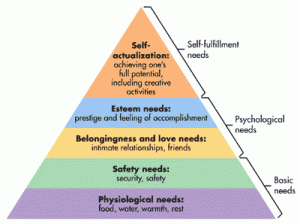Whatever our understanding of how human motivation operates – whether we are interested in improving how we motivate ourselves, or others – we are aware that employee motivation is a key driver of productivity and achievement in our organisation. Daniel Pink, author of ‘Drive’, argues that our understanding of what drives our behaviour in the workplace needs to be upgraded from the belief in the universal effectiveness of punishment and reward, and he puts forward the idea that there are three universal motivators that drive our behaviour:
- autonomy – the need to direct our own lives. In essence this is about the sense of freedom, the need to do what we do in our own way, the need to feel we have some power and control over our lives and actions. The opposite of this is dictatorship, micromanagement, loss of power and dignity, and learned helplessness.
- mastery – the need to learn and create new things. We are genetically programmed to learn, problem-solve, grow, innovate, create. It is this motivator that drives us to learn to walk, to talk, to read and write, to master the clarinet. We intrinsically WANT to get better at what we do.
- purpose – the WHY of what we are doing. Usually this involves a deep understanding and resonance with the way/s in which we are part of a bigger picture. How does what we do improve our lives and the lives of others? How do we contribute in some small or large way to the wellbeing of the planet and other beings?
How does this fit in with Maslow’s traditional theory of motivation?
Abraham Maslow’s hierarchy of behavioural motivation is well known, so how does this relate to Pink’s theory?
 Pink argues that – at least in the Western world -we are largely able to satisfy the basic survival needs. Most of us are able to provide ourselves with a reasonable level of food, shelter and safety – and therefore this no longer functions as an adequate source of motivation in the workforce.
Pink argues that – at least in the Western world -we are largely able to satisfy the basic survival needs. Most of us are able to provide ourselves with a reasonable level of food, shelter and safety – and therefore this no longer functions as an adequate source of motivation in the workforce.
He also argues that in the current economic environment the carrot-and-stick paradigm does not encourage the innovation and creativity that gives leading organisations the competitive edge. He believes that we have largely moved beyond these earlier models of motivation and we need to access the intrinsic motivation of employees, and therefore we should be tapping into the psychological and self-fulfillment needs, rather than relying on external reward-and-punishment motivators.
How can we apply this in the workplace?
If we’re looking to increase our own (or our team’s) motivation, it may be useful to look at these three areas:
- autonomy – how can I increase my sense of having control over the tasks and projects in my role, while still achieving the end results required? How much input do I have to my KRAs? My work hours? Where can I gain more ability to direct my work-flow? How can I create the space where I am able to achieve good results in a way that works for me?
- mastery – where can I grow? What interests me about what I do? What would help me do my work better? What resources/support/training do I need? What new projects would I like to take on/expand/improve? Where can I innovate? How will I get the positive, useful and constructive feedback that I need? What markers will I set up so that I can see progress/improvement?
- purpose – why am I doing what I do? Beyond the paycheck, what role does my work serve? Does that resonate or have meaning for me? How can I better align what I do with my own personal values? What are my own personal values? How does what I do contribute in some small or large way to myself and/or others having a better life?
If we are able to connect to these three intrinsic motivators, we are in a much better position to clarify what we are doing and why. Making small shifts along these lines may enable us to better access our own and other’s inner energy and drive to do what we need to do.
